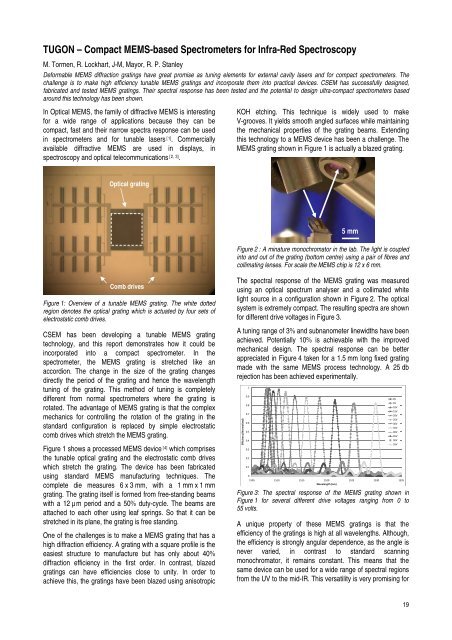research activities in 2007 - CSEM
research activities in 2007 - CSEM
research activities in 2007 - CSEM
You also want an ePaper? Increase the reach of your titles
YUMPU automatically turns print PDFs into web optimized ePapers that Google loves.
TUGON – Compact MEMS-based Spectrometers for Infra-Red Spectroscopy<br />
M. Tormen, R. Lockhart, J-M, Mayor, R. P. Stanley<br />
Deformable MEMS diffraction grat<strong>in</strong>gs have great promise as tun<strong>in</strong>g elements for external cavity lasers and for compact spectrometers. The<br />
challenge is to make high efficiency tunable MEMS grat<strong>in</strong>gs and <strong>in</strong>corporate them <strong>in</strong>to practical devices. <strong>CSEM</strong> has successfully designed,<br />
fabricated and tested MEMS grat<strong>in</strong>gs. Their spectral response has been tested and the potential to design ultra-compact spectrometers based<br />
around this technology has been shown.<br />
In Optical MEMS, the family of diffractive MEMS is <strong>in</strong>terest<strong>in</strong>g<br />
for a wide range of applications because they can be<br />
compact, fast and their narrow spectra response can be used<br />
<strong>in</strong> spectrometers and for tunable lasers [1] . Commercially<br />
available diffractive MEMS are used <strong>in</strong> displays, <strong>in</strong><br />
spectroscopy and optical telecommunications [2, 3] .<br />
Optical grat<strong>in</strong>g<br />
Comb drives<br />
Figure 1: Overview of a tunable MEMS grat<strong>in</strong>g. The white dotted<br />
region denotes the optical grat<strong>in</strong>g which is actuated by four sets of<br />
electrostatic comb drives.<br />
<strong>CSEM</strong> has been develop<strong>in</strong>g a tunable MEMS grat<strong>in</strong>g<br />
technology, and this report demonstrates how it could be<br />
<strong>in</strong>corporated <strong>in</strong>to a compact spectrometer. In the<br />
spectrometer, the MEMS grat<strong>in</strong>g is stretched like an<br />
accordion. The change <strong>in</strong> the size of the grat<strong>in</strong>g changes<br />
directly the period of the grat<strong>in</strong>g and hence the wavelength<br />
tun<strong>in</strong>g of the grat<strong>in</strong>g. This method of tun<strong>in</strong>g is completely<br />
different from normal spectrometers where the grat<strong>in</strong>g is<br />
rotated. The advantage of MEMS grat<strong>in</strong>g is that the complex<br />
mechanics for controll<strong>in</strong>g the rotation of the grat<strong>in</strong>g <strong>in</strong> the<br />
standard configuration is replaced by simple electrostatic<br />
comb drives which stretch the MEMS grat<strong>in</strong>g.<br />
Figure 1 shows a processed MEMS device [4] which comprises<br />
the tunable optical grat<strong>in</strong>g and the electrostatic comb drives<br />
which stretch the grat<strong>in</strong>g. The device has been fabricated<br />
us<strong>in</strong>g standard MEMS manufactur<strong>in</strong>g techniques. The<br />
complete die measures 6 x 3 mm, with a 1 mm x 1 mm<br />
grat<strong>in</strong>g. The grat<strong>in</strong>g itself is formed from free-stand<strong>in</strong>g beams<br />
with a 12 µm period and a 50% duty-cycle. The beams are<br />
attached to each other us<strong>in</strong>g leaf spr<strong>in</strong>gs. So that it can be<br />
stretched <strong>in</strong> its plane, the grat<strong>in</strong>g is free stand<strong>in</strong>g.<br />
One of the challenges is to make a MEMS grat<strong>in</strong>g that has a<br />
high diffraction efficiency. A grat<strong>in</strong>g with a square profile is the<br />
easiest structure to manufacture but has only about 40%<br />
diffraction efficiency <strong>in</strong> the first order. In contrast, blazed<br />
grat<strong>in</strong>gs can have efficiencies close to unity. In order to<br />
achieve this, the grat<strong>in</strong>gs have been blazed us<strong>in</strong>g anisotropic<br />
KOH etch<strong>in</strong>g. This technique is widely used to make<br />
V-grooves. It yields smooth angled surfaces while ma<strong>in</strong>ta<strong>in</strong><strong>in</strong>g<br />
the mechanical properties of the grat<strong>in</strong>g beams. Extend<strong>in</strong>g<br />
this technology to a MEMS device has been a challenge. The<br />
MEMS grat<strong>in</strong>g shown <strong>in</strong> Figure 1 is actually a blazed grat<strong>in</strong>g.<br />
Figure 2 : A m<strong>in</strong>ature monochromator <strong>in</strong> the lab. The light is coupled<br />
<strong>in</strong>to and out of the grat<strong>in</strong>g (bottom centre) us<strong>in</strong>g a pair of fibres and<br />
collimat<strong>in</strong>g lenses. For scale the MEMS chip is 12 x 6 mm.<br />
The spectral response of the MEMS grat<strong>in</strong>g was measured<br />
us<strong>in</strong>g an optical spectrum analyser and a collimated white<br />
light source <strong>in</strong> a configuration shown <strong>in</strong> Figure 2. The optical<br />
system is extremely compact. The result<strong>in</strong>g spectra are shown<br />
for different drive voltages <strong>in</strong> Figure 3.<br />
A tun<strong>in</strong>g range of 3% and subnanometer l<strong>in</strong>ewidths have been<br />
achieved. Potentially 10% is achievable with the improved<br />
mechanical design. The spectral response can be better<br />
appreciated <strong>in</strong> Figure 4 taken for a 1.5 mm long fixed grat<strong>in</strong>g<br />
made with the same MEMS process technology. A 25 db<br />
rejection has been achieved experimentally.<br />
Efficiency (Normalized)<br />
1<br />
0.9<br />
0.8<br />
0.7<br />
0.6<br />
0.5<br />
0.4<br />
0.3<br />
0.2<br />
0.1<br />
0<br />
5 mm<br />
1505 1510 1515 1520<br />
Wavelength (nm)<br />
1525 1530 1535<br />
Figure 3: The spectral response of the MEMS grat<strong>in</strong>g shown <strong>in</strong><br />
Figure 1 for several different drive voltages rang<strong>in</strong>g from 0 to<br />
55 volts.<br />
A unique property of these MEMS grat<strong>in</strong>gs is that the<br />
efficiency of the grat<strong>in</strong>gs is high at all wavelengths. Although,<br />
the efficiency is strongly angular dependence, as the angle is<br />
never varied, <strong>in</strong> contrast to standard scann<strong>in</strong>g<br />
monochromator, it rema<strong>in</strong>s constant. This means that the<br />
same device can be used for a wide range of spectral regions<br />
from the UV to the mid-IR. This versatility is very promis<strong>in</strong>g for<br />
0V<br />
5V<br />
10V<br />
15V<br />
20V<br />
25V<br />
30V<br />
35V<br />
40V<br />
45V<br />
50V<br />
55V<br />
19








